



HAR KADAM
HAIN SAATH HUM




HAR KADAM
HAIN SAATH HUM




HAR KADAM
HAIN SAATH HUM




HAR KADAM
HAIN SAATH HUM


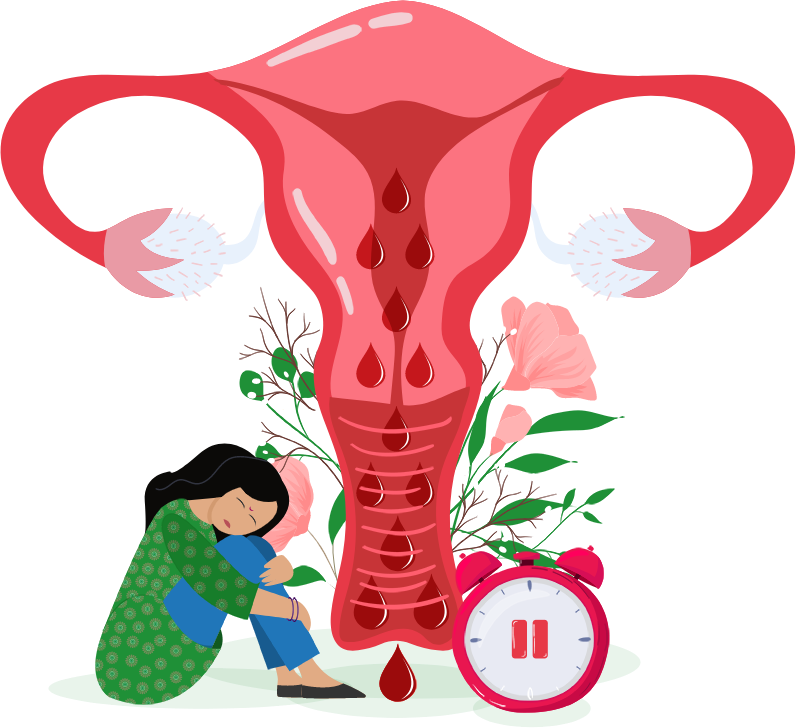
What is Abnormal uterine bleeding?
Abnormal uterine bleeding (AUB) refers to any bleeding that is different from normal monthly periods.1 Normal periods occur at an interval of 24 to 38 days, last for 2 to 7 days and result in a blood loss of 5 to 80 mL.2 You may experience changes with respect to the regularity, duration, frequency or volume of blood flow during periods.3 If you notice changes in any of these parameters, you may have abnormal uterine bleeding.2 However, if you experience periods with abnormally heavy bleeding or longer duration of bleeding, you might have heavy menstrual bleeding (HMB).4

Abnormal uterine bleeding occurs in about one-third of women in their life, with irregularities most commonly occurring at menarche (first occurrence of periods) and perimenopause (around the time of menopause; menopause means permanent end of periods).2
In India, around 18% of women have abnormal uterine bleeding.5 It can affect the quality of social, mental and emotional health of women to a great extent.6
References:
1. Gerema U, Kene K, Abera D, et al. Abnormal uterine bleeding and associated factors among reproductive age women in Jimma town, Oromia Region, Southwest Ethiopia. Womens Health. 2022;18:1-7.
2. Davis E, Sparzak PB. Abnormal uterine bleeding. In: StatPearls. [Internet]. 2022 Sep 09 [cited 2022 Dec 23]. Available from: https://www.ncbi.nlm.nih.gov/books/NBK532913/
3. Livingstone M, Fraser IS. Mechanisms of abnormal uterine bleeding. Hum Reprod Update. 2002;8(1):60-7.
4. Mayo Clinic. Menorrhagia (heavy menstrual bleeding). [Internet]. 2022 Jun 25 [cited 2022 Dec 05]. Available from: https://www.mayoclinic.org/diseases-conditions/menorrhagia/symptoms-causes/syc-20352829
5. National Health Portal of India. Abnormal uterine bleeding. [Internet]. 2017 Jul 28 [cited 2022 Dec 23]. Available from: https://www.nhp.gov.in/disease/gynaecology-and-obstetrics/abnormal-uterine-bleeding
6. Henry C, Ekeroma A, Filoche S. Barriers to seeking consultation for abnormal uterine bleeding: Systematic review of qualitative research. BMC Womens Health. 2020;20(1):123.
Signs and Symptoms of Abnormal Uterine Bleeding
you have abnormal uterine bleeding

Irregular bleeding
or spotting
You may experience bleeding or spotting
(a drop or two of blood) between
your periods or after sexual
intercourse1,2

Heavy bleeding during
your periods
You may bleed so heavily that
it might soak one or more pads or
tampons every hour or bleeding may
last for more than 7 days1,2

Frequent or
late cycles
Period cycles lasting longer
than 38 days or shorter than
24 days3

Irregular and longer period cycles
Irregular periods in which bleeding days differ by more than 7-9 days3

Delayed periods
Missing your periods for 3 to 6 months2

Post-menopausal
bleeding
Bleeding after menopause
(periods stop permanently)3
to talk to your doctor for proper diagnosis and treatment.
References:
1. WebMD. Abnormal uterine bleeding. [Internet] 2022 Sep 07 [cited 2022 Dec 23]. Available from: https://www.webmd.com/women/abnormal-uterine-bleeding
2.. American College of Obstetricians and Gynecologists. Abnormal uterine bleeding. [Internet] 2021 Dec [cited 2022 Dec 23]. Available from: https://www.acog.org/womens-health/faqs/abnormal-uterine-bleeding
3. . National Health Portal of India. Abnormal uterine bleeding. [Internet] 2017 Jul 28 [cited 2022 Dec 23]. Available from: https://www.nhp.gov.in/disease/gynaecology-and-obstetrics/abnormal-uterine-bleeding
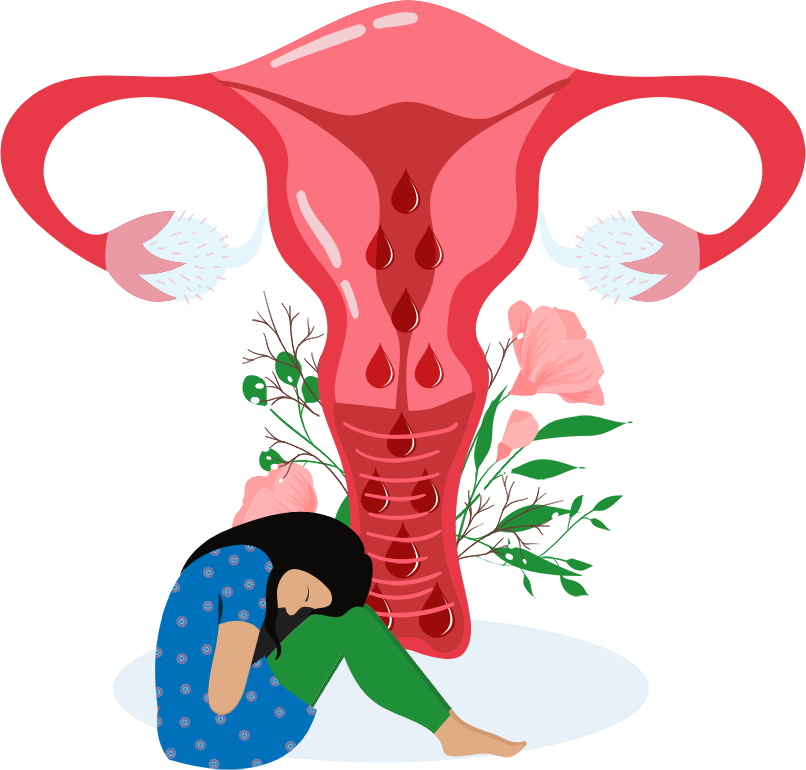
What are the causes of Abnormal uterine bleeding ?
The PLAM-COEIN system introduced by the International Federation of Gynecology and Obstetrics (FIGO) has identified the causes of AUB.

he core causes that determine the PALM group can be located using imaging methods and/or histopathology, these are P- Polyp; A- Adenomyosis; L- Leiomyoma; M- Malignancy and hyperplasia. The other causes of AUB that are not determined by imaging or histology are related to the COEIN group (C- Coagulopathy; O- Ovulatory dysfunction; E- Endometrial; I- Iatrogenic; and N- Not yet classified).1,2,3
References:
1. WebMD. Abnormal uterine bleeding. [Internet] 2022 Sep 07 [cited 2022 Jan 24]. Available from: https://www.webmd.com/women/abnormal-uterine-bleeding.
2. National Health Portal of India. Abnormal uterine bleeding. [Internet] 2017 Jul 28 [cited 2022 Jan 24]. Available from: https://www.nhp.gov.in/disease/gynaecology-and-obstetrics/abnormal-uterine-bleeding.
3.American College of Obstetricians and Gynecologists. Abnormal uterine bleeding. [Internet] 2021 Dec [cited 2022 Jan 24]. Available from: https://www.acog.org/womens-health/faqs/abnormal-uterine-bleeding.
What are the Causes of Abnormal Uterine Bleeding?
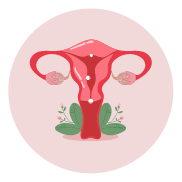
Hormonal changes
Abnormal uterine bleeding is commonly caused due to hormonal changes. In teenagers and women approaching menopause, there can be an excess build-up of the inner lining of the uterus. This can lead to spotting between periods, irregular or heavy periods.1
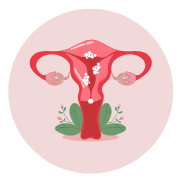
Polyps
Uterine polyps are growths in the uterus present in the inner lining. Most of the time, they are not cancerous, but sometimes can be precancerous or cancerous.2

Cancer
Sometimes, abnormal uterine bleeding can be caused due to cancer of the uterus, cervix, or endometrium.1
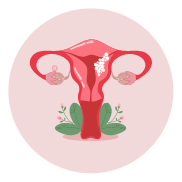
Problems with ovulation
When there are problems with ovulation (release of an egg), it can affect your period in different ways. This can cause no periods, very light and infrequent periods, or heavy bleeding at unexpected times.2

Bleeding disorder
If your blood does not clot properly, you can have heavy bleeding.3
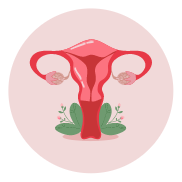
Medications
The use of birth control methods can cause bleeding at a time other than your period. Some medicines, like blood thinners, can lead to heavy bleeding during your periods. 3
References:
1. WebMD. Abnormal uterine bleeding. [Internet] 2022 Sep 07 [cited 2022 Jan 24]. Available from: https://www.webmd.com/women/abnormal-uterine-bleeding
2. National Health Portal of India. Abnormal uterine bleeding. [Internet] 2017 Jul 28 [cited 2022 Jan 24]. Available from: https://www.nhp.gov.in/disease/gynaecology-and-obstetrics/abnormal-uterine-bleeding
3.American College of Obstetricians and Gynecologists. Abnormal uterine bleeding. [Internet] 2021 Dec [cited 2022 Jan 24]. Available from: https://www.acog.org/womens-health/faqs/abnormal-uterine-bleeding
How is Abnormal Uterine Bleeding Diagnosed?

Medical history
In order to diagnose your condition, your doctor will ask you about your personal and family health history, including past and present illnesses and surgeries, birth control methods, and pregnancy history. Your doctor will also ask about the details of your periods, such as frequency, amount, regularity, and painful bleeding.1,2

Physical examination
Your doctor may conduct a physical examination, including an examination of the pelvis.1

Laboratory tests
Your doctor may advise blood tests, such as a complete blood count (CBC), to check for anaemia or infection. You may also be advised for a urine pregnancy test to make sure you are not pregnant.1,2

Ultrasound
An ultrasound test uses sound waves to take pictures of the inside of your uterus. This helps the doctor to look for growths, like fibroids or polyps.3

Hysteroscopy
A hysteroscopy is a test where a thin tube with a light is inserted through the vagina into the uterus. This helps your doctor to look for any abnormalities in the uterus.1,2

Magnetic resonance imaging
Magnetic resonance imaging (MRI) is a test that creates detailed pictures of organs and tissues in your body using a magnetic field and radio waves. It can be used to map the exact location of fibroids (non-cancerous growths) while planning surgery.2,4
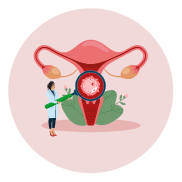
Endometrial biopsy
Endometrial biopsy is a test where a small sample of tissue is taken from the inside of the uterus and examined under a microscope to look for any abnormal cells.2,5

Computed tomography
Computed tomography (CT) is a test that uses X-rays to produce cross-sectional images of internal organs and structures.2 It helps determine the exact size and location of fibroids (non-cancerous growths).6
References:
1. American College of Obstetricians and Gynecologists. Abnormal uterine bleeding. [Internet] 2021 Dec [cited 2022 Dec 23]. Available from: https://www.acog.org/womens-health/faqs/abnormal-uterine-bleeding
2. National Health Portal of India. Abnormal uterine bleeding. [Internet] 2017 Jul 28 [cited 2022 Dec 23]. Available from: https://www.nhp.gov.in/disease/gynaecology-and-obstetrics/abnormal-uterine-bleeding
3. WebMD. Abnormal uterine bleeding. [Internet] 2022 Sep 07 [cited 2022 Dec 23]. Available from: https://www.webmd.com/women/abnormal-uterine-bleeding
4.Mayo Clinic. MRI. [Internet] 2021 Sep 04 [cited 2022 Dec 28]. Available from: https://www.mayoclinic.org/tests-procedures/mri/about/pac-20384768
5. Johns Hopkins Medicine. Endometrial biopsy. [Internet] [cited 2022 Dec 28]. Available from: https://www.hopkinsmedicine.org/health/treatment-tests-and-therapies/endometrial-biopsy
6.Hatasaka H. The evaluation of abnormal uterine bleeding. Clin Obstet Gynecol. 2005;48(2):258-73.

Treatment of Abnormal Uterine Bleeding
Medical Treatment
Hormone treatments
Hormone treatments help regulate your periods and make your periods lighter. One example of this type of treatment is birth control pills.1
GONADOTROPIN-RELEASING HORMONE AGONISTS (GnRHa)
Gonadotrophin-releasing hormone agonists are medicines that stop your body from producing certain hormones. They can temporarily reduce the size of fibroids (non-cancerous growths). These medicines are often used together with other treatments.1
NON-STEROIDAL ANTI-INFLAMMATORY DRUGS (NSAIDs)
Non-steroidal anti-inflammatory drugs if taken a few days before the start of periods may help reduce the amount of bleeding. Examples of these drugs include ibuprofen and naproxen.1
Tranexamic acid
Tranexamic acid is a medication that helps your blood clot and can control heavy bleeding.1
Intrauterine device (IUD)
Intrauterine device that releases a hormone called progestin can help stop heavy bleeding in some women. The use of an IUD in many women may lead to no periods at all.1
References:
1.WebMD. Abnormal uterine bleeding. [Internet] 2022 Sep 07 [cited 2023 Jan 24]. Available from: https://www.webmd.com/women/abnormal-uterine-bleeding
2. National Health Portal of India. Abnormal uterine bleeding. [Internet] 2017 Jul 28 [cited 2023 Jan 24]. Available from: https://www.nhp.gov.in/disease/gynaecology-and-obstetrics/abnormal-uterine-bleeding
Surgical Treatment
Endometrial ablation
Endometrial ablation is a procedure where the inner lining of the uterus is destroyed using methods such as cold, heat, electricity, or a laser. It helps stop or reduce bleeding.1,2
Myomectomy
Myomectomy is a surgical procedure to remove fibroids (non-cancerous growths).2
Uterine artery embolisation
Uterine artery embolisation is a procedure used to treat fibroids (non-cancerous growths). In this procedure, the blood vessels to the uterus are blocked. This in turn stops the blood supply that fibroids need to grow.2
Hysterectomy
Hysterectomy is a surgical procedure to remove the uterus.1,2
References:
1.WebMD. Abnormal uterine bleeding. [Internet] 2022 Sep 07 [cited 2023 Jan 24]. Available from: https://www.webmd.com/women/abnormal-uterine-bleeding
2. National Health Portal of India. Abnormal uterine bleeding. [Internet] 2017 Jul 28 [cited 2023 Jan 24]. Available from: https://www.nhp.gov.in/disease/gynaecology-and-obstetrics/abnormal-uterine-bleeding
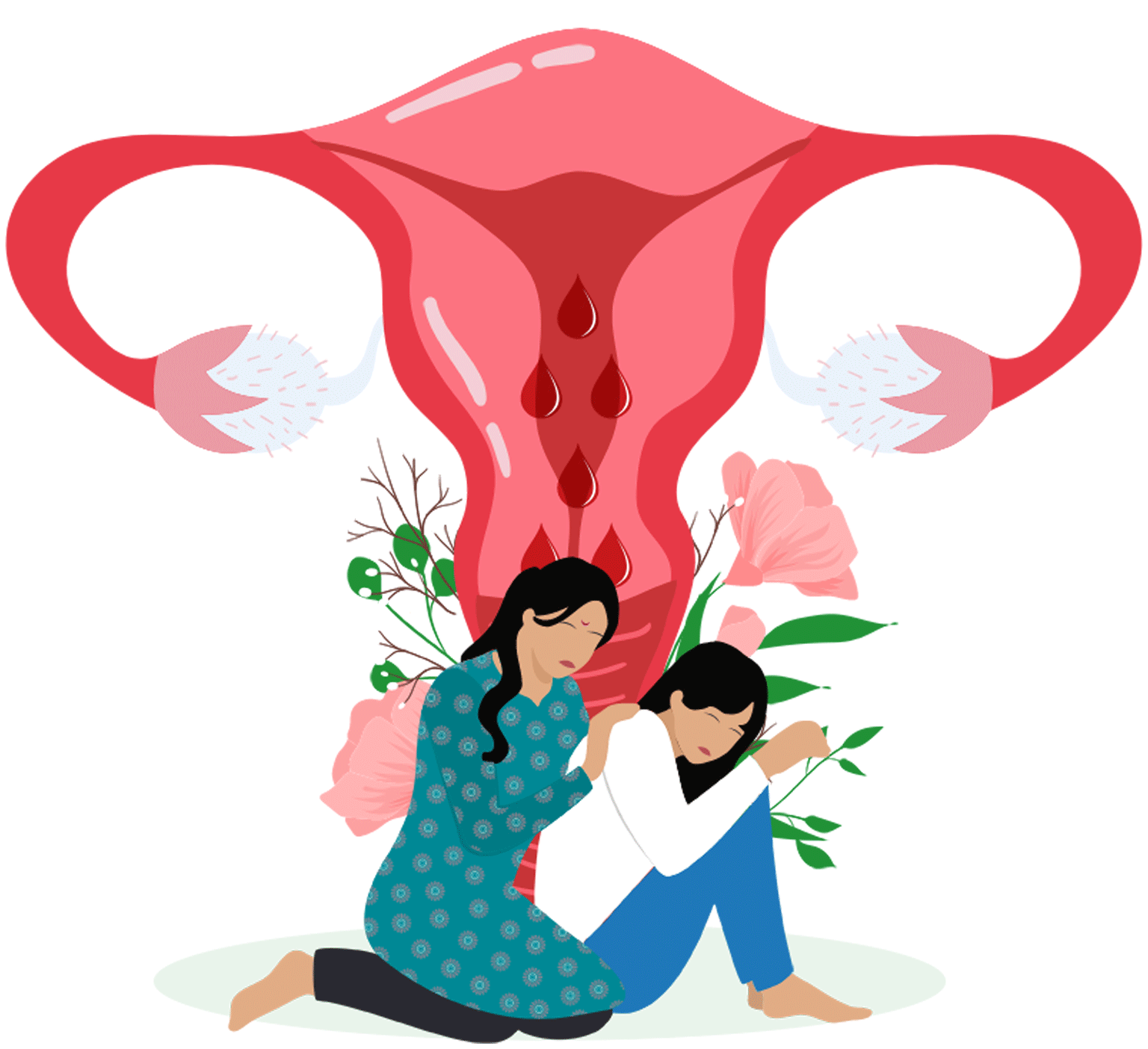
What is Abnormal uterine bleeding in adolescents?
Adolescence is the phase of life between being a child and an adult, from the ages 10 to 19.1 Normal periods in adolescents occur at an interval of 21 to 40 days, last for 2 to 7 days and result in a blood loss of 20 to 80 mL.2 Abnormal uterine bleeding (AUB) refers to any change from normal monthly periods; including irregular, too heavy, longer duration and/or frequent bleeding from the uterus.2,3

Abnormal uterine bleeding is a common problem in the adolescent age group. The majority of the abnormal uterine bleeding in adolescents is related to physiologic ovulatory dysfunction (absence of release of an egg from the ovary).3
Abnormal uterine bleeding reduces the quality of life, affects school attendance, and limits participation in sports and social activities.4
References:
1. World Health Organization. Adolescent health. [Internet] [cited 2022 Dec 23]. Available from: https://www.who.int/health-topics/adolescent-health#tab=tab_1
2. Ozge Y, Tuncay Y, Orhun CM. Overview of abnormal uterine bleeding in adolescents: diagnosis and management. International Journal of Women’s Health and Reproduction Sciences. 2017;5(3):158-63.
3. Pecchioli Y, Oyewumi L, Allen LM, et al. The utility of routine ultrasound in the diagnosis and management of adolescents with abnormal uterine bleeding. J Pediatr Adolesc Gynecol. 2017;30(2):239-42.
4.Yaşa C, Güngör Uğurlucan F. Approach to abnormal uterine bleeding in adolescents. J Clin Res Pediatr Endocrinol. 2020;12(Suppl 1):1-6.
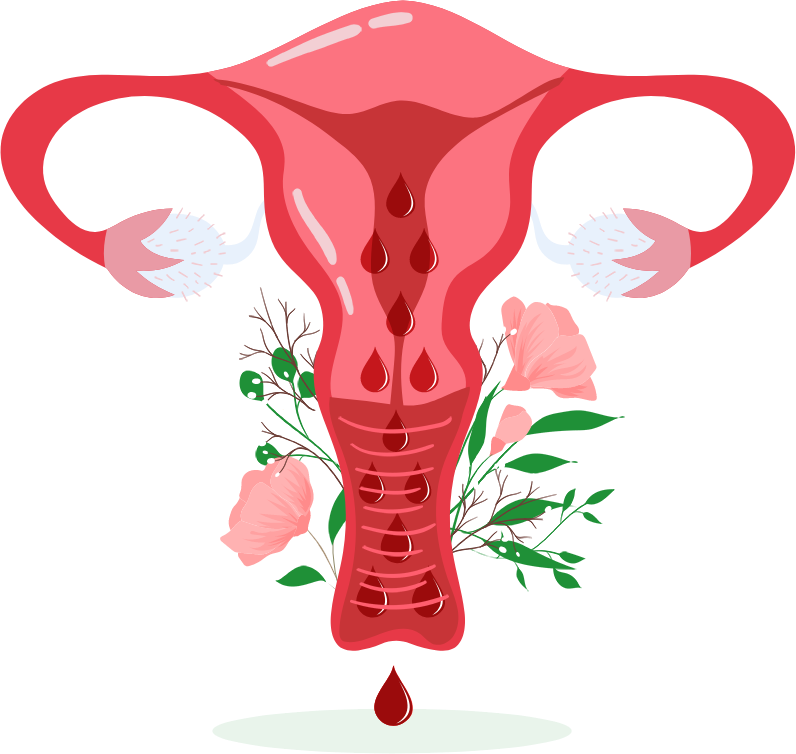
TREATMENT OF ABNORMAL UTERINE BLEEDING IN ADOLESCENTS
Medical Treatment
Tranexamic acid
Tranexamic acid is a medication that helps reduce bleeding. However, it does not affect the duration of bleeding or regularity of periods.1
Hormonal treatment
A type of birth control that contains both hormones, oestrogen and progesterone helps reduce bleeding during periods.2
Desmopressin
Desmopressin is a medicine used to prevent and control bleeding episodes in those having a blood clotting disorder. 1
Iron supplements
If you have anaemia, your doctor may recommend taking iron supplements along with other treatments.3
References:
1. The Federation of Obstetric and Gynaecological Societies of India. Abnormal uterine bleeding. [Internet] 2020 [cited 2022 Dec 26]. Available from: https://fogsi.org/wp-content/uploads/fogsi-focus/fogsi-focus-abnormal-uterine-bleeding-2021.pdf
2. Wilkinson JP, Kadir RA. Management of abnormal uterine bleeding in adolescents. J Pediatr Adolesc Gynecol. 2010 Dec;23(6 Suppl):S22-30.
3. Hernandez A, Dietrich JE. Abnormal uterine bleeding in the adolescent. Obstet Gynecol. 2020;135(3):615-21.
4. Johns Hopkins Medicine. Dilatation and curettage. [Internet] 2021 Oct 19 [cited 2022 Dec 29]. Available from: https://www.hopkinsmedicine.org/health/treatment-tests-and-therapies/dilation-and-curettage-d-and-c
5. WebMD. Hysterectomy. [Internet] 2021 Feb 04 [cited 2022 Dec 26]. Available from: https://www.webmd.com/women/guide/hysterectomy
6. Mayo Clinic. Endometrial ablation. [Internet] 2022 Dec 20 [cited 2022 Dec 26]. Available from: https://www.mayoclinic.org/tests-procedures/endometrial-ablation/about/pac-20393932
Surgical Treatment
Uterine tamponade therapy
Uterine tamponade therapy is a procedure where a thin tube with an attached balloon is inserted into the uterus. The balloon on the tube is inflated with saline until resistance is met and bleeding stops.2,3
Dilation and curettage
Dilation and curettage is a surgical procedure wherein the doctor dilates the opening of the uterus and uses a special tool to scrape the inner lining. This is done to remove any abnormal tissue.3,4
Hysterectomy
Hysterectomy is a surgical procedure to remove the uterus.3,5
Endometrial ablation
Endometrial ablation is a procedure where the inner lining of the uterus is destroyed using methods such as extreme cold, heated fluids, microwave energy, or high-energy radiofrequencies. It helps reduce bleeding.3,6
References:
1. The Federation of Obstetric and Gynaecological Societies of India. Abnormal uterine bleeding. [Internet] 2020 [cited 2022 Dec 26]. Available from: https://fogsi.org/wp-content/uploads/fogsi-focus/fogsi-focus-abnormal-uterine-bleeding-2021.pdf
2. Wilkinson JP, Kadir RA. Management of abnormal uterine bleeding in adolescents. J Pediatr Adolesc Gynecol. 2010 Dec;23(6 Suppl):S22-30.
3. Hernandez A, Dietrich JE. Abnormal uterine bleeding in the adolescent. Obstet Gynecol. 2020;135(3):615-21.
4. Johns Hopkins Medicine. Dilatation and curettage. [Internet] 2021 Oct 19 [cited 2022 Dec 29]. Available from: https://www.hopkinsmedicine.org/health/treatment-tests-and-therapies/dilation-and-curettage-d-and-c
5. WebMD. Hysterectomy. [Internet] 2021 Feb 04 [cited 2022 Dec 26]. Available from: https://www.webmd.com/women/guide/hysterectom
6. Mayo Clinic. Endometrial ablation. [Internet] 2022 Dec 20 [cited 2022 Dec 26]. Available from: https://www.mayoclinic.org/tests-procedures/endometrial-ablation/about/pac-20393932
